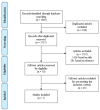Combined Aerobic and Resistance Exercise in Walking Performance of Patients With Intermittent Claudication: Systematic Review
- PMID: 31969830
- PMCID: PMC6960137
- DOI: 10.3389/fphys.2019.01538
Combined Aerobic and Resistance Exercise in Walking Performance of Patients With Intermittent Claudication: Systematic Review
Abstract
Background: The short-term benefits of aerobic and resistance exercise in subjects affected by Peripheral Arterial Disease (PAD) are scarcely examined in interaction. This study aimed to identify the effects of combined aerobic and resistance exercise programs on walking performance compared with isolated aerobic exercise or with the usual care in patients with intermittent claudication. Methods: A systematic review was conducted following the PRISMA statement. A total of five electronic databases were searched (until October 2019) for randomized and non-randomized controlled trials. The focus comprised PAD patients with intermittent claudication who performed a combined aerobic and resistance exercise program that assessed the walking performance. Results: Seven studies include combined aerobic and resistance exercise vs. isolated aerobic or vs. usual care. The studies represented a sample size of 337 participants. The follow-up ranged from 4 to 12 weeks, 2 to 5 times-per-week. The risk of bias in the trials was a deemed moderate-to-high risk. After the interventions, the percent change in walking performance outcomes had a large variation. In the combined and isolated aerobic programs, the walking performance always improved, while in the usual care group oscillates between the deterioration and the improvement in all outcomes. Combined exercise and isolated aerobic exercise improved the claudication onset distance from 11 to 396%, and 30 to 422%, the absolute claudication distance from 81 to 197%, and 53 to 121%, and the maximal walking distance around 23 and 10%, respectively. Conclusions: Currently, there is insufficient evidence about the effects of combined aerobic and resistance exercise compared to isolated aerobic exercise or usual care on walking performance. However, despite the low quality of evidence, the combined aerobic and resistance exercise seems to be an effective strategy to improve walking performance in patients with intermittent claudication. These combined exercise modes or isolated aerobic exercise produce positive and significant results on walking performance. The usual care approach has a trend to deteriorate the walking performance. Thus, given the scarcity of data, new randomized controlled trial studies that include assessments of cardiovascular risk factors are urgently required to better determine the effect of this exercise combination.
Keywords: combined aerobic and resistance training; intermittent claudication; peripheral arterial disease; systematic review; walking performance.
Copyright © 2020 Machado, Sousa, Paredes, Ferreira and Abrantes.
Figures
Similar articles
-
Effects of aerobic and combined training on pain-free walking distance and health-related quality of life in patients with peripheral artery disease: a randomized clinical trial.J Vasc Bras. 2023 Aug 28;22:e20230024. doi: 10.1590/1677-5449.202300242. eCollection 2023. J Vasc Bras. 2023. PMID: 37790896 Free PMC article.
-
A pilot exercise intervention to improve lower extremity functioning in peripheral arterial disease unaccompanied by intermittent claudication.J Cardiopulm Rehabil. 2004 May-Jun;24(3):187-96. doi: 10.1097/00008483-200405000-00010. J Cardiopulm Rehabil. 2004. PMID: 15235301 Clinical Trial.
-
Comparison of the effect of upper body-ergometry aerobic training vs treadmill training on central cardiorespiratory improvement and walking distance in patients with claudication.J Vasc Surg. 2011 Jun;53(6):1557-64. doi: 10.1016/j.jvs.2011.01.077. Epub 2011 Apr 23. J Vasc Surg. 2011. PMID: 21515017 Clinical Trial.
-
The Impact of Supervised Exercise Training on Traditional Cardiovascular Risk Factors in Patients With Intermittent Claudication: A Systematic Review and Meta-Analysis.Eur J Vasc Endovasc Surg. 2019 Jul;58(1):75-87. doi: 10.1016/j.ejvs.2018.12.014. Epub 2019 May 30. Eur J Vasc Endovasc Surg. 2019. PMID: 31153735
-
Exercise training for intermittent claudication.J Vasc Surg. 2017 Nov;66(5):1612-1620. doi: 10.1016/j.jvs.2017.05.111. Epub 2017 Sep 2. J Vasc Surg. 2017. PMID: 28874320 Free PMC article. Review.
Cited by
-
Effects of aerobic and combined training on pain-free walking distance and health-related quality of life in patients with peripheral artery disease: a randomized clinical trial.J Vasc Bras. 2023 Aug 28;22:e20230024. doi: 10.1590/1677-5449.202300242. eCollection 2023. J Vasc Bras. 2023. PMID: 37790896 Free PMC article.
-
Patients with Diabetes Complicated by Peripheral Artery Disease: the Current State of Knowledge on Physiotherapy Interventions.J Diabetes Res. 2021 May 10;2021:5122494. doi: 10.1155/2021/5122494. eCollection 2021. J Diabetes Res. 2021. PMID: 34056006 Free PMC article. Review.
-
Supervised physical activity in patients with symptomatic peripheral arterial disease: protocol for a randomized clinical trial (ARTPERfit Study).BMJ Open. 2022 Apr 27;12(4):e054352. doi: 10.1136/bmjopen-2021-054352. BMJ Open. 2022. PMID: 35477870 Free PMC article.
-
Detection of Intermittent Claudication from Smartphone Inertial Data in Community Walks Using Machine Learning Classifiers.Sensors (Basel). 2023 Feb 1;23(3):1581. doi: 10.3390/s23031581. Sensors (Basel). 2023. PMID: 36772621 Free PMC article.
-
Lower limb revascularization leads to faster walking but with less efficient mechanics in claudicating patients.J Biomech. 2024 Jan;162:111880. doi: 10.1016/j.jbiomech.2023.111880. Epub 2023 Nov 22. J Biomech. 2024. PMID: 38070293 Free PMC article.
References
-
- Aboyans V., Ricco J. B., Bartelink M. E. L., Bjorck M., Brodmann M., Cohnert T., et al. (2018). 2017 ESC guidelines on the diagnosis and treatment of peripheral arterial diseases, in collaboration with the European society for vascular surgery (ESVS). Eur. J. Vasc. Endovasc. Surg. 55, 305–368. 10.1016/j.ejvs.2017.07.018 - DOI - PubMed
-
- Baker W. B., Li Z., Schenkel S. S., Chandra M., Busch D. R., Englund E. K., et al. . (2017). Effects of exercise training on calf muscle oxygen extraction and blood flow in patients with peripheral artery disease. J. Appl. Physiol. 123, 1599–1609. 10.1152/japplphysiol.00585.2017 - DOI - PMC - PubMed
-
- Currie K. D., Bailey K. J., Jung M. E., McKelvie R. S., MacDonald M. J. (2015). Effects of resistance training combined with moderate-intensity endurance or low-volume high-intensity interval exercise on cardiovascular risk factors in patients with coronary artery disease. J. Sci. Med. Sport 18, 637–642. 10.1016/j.jsams.2014.09.013 - DOI - PubMed
-
- Delaney C. L., Miller M. D., Chataway T. K., Spark J. I. (2014). A randomised controlled trial of supervised exercise regimens and their impact on walking performance, skeletal muscle mass and calpain activity in patients with intermittent claudication. Eur. J. Vasc. Endovasc. Surg. 47, 304–310. 10.1016/j.ejvs.2013.12.021 - DOI - PubMed
Publication types
LinkOut - more resources
Full Text Sources


